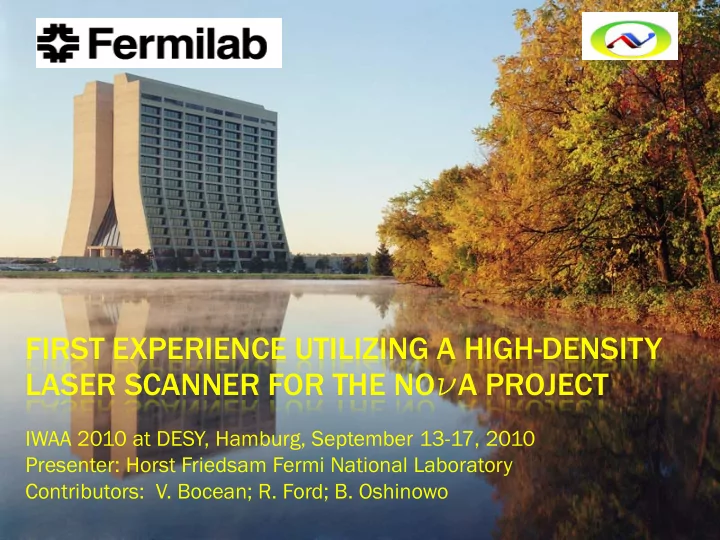

FIRST EXPERIENCE UTILIZING A HIGH-DENSITY LASER SCANNER FOR THE NO n A PROJECT IWAA 2010 at DESY, Hamburg, September 13-17, 2010 Presenter: Horst Friedsam Fermi National Laboratory Contributors: V. Bocean; R. Ford; B. Oshinowo
OUTLINE: Project Overview 1. NO n A Far Detector Design 2. The LEICA HDS6100 Laser Scanner 3. Proposed Measurement and Data Analysis 4. Summary 5.
PROJECT OVERVIEW The NuMI Off-Axis n e Appearance Experiment (NO NO n A) project is currently under construction. Utilizes the NuMI beam created at Fermilab that is directed to a 700 m below ground detector at the Soudan Mine in Minnesota about 735 Km due North of Fermilab. The new NO n A far detector is placed at Ash River, Minnesota about 75 Km further north and 11 Km off-axis intercepting the neutrino beam at a different energy state under a 13.6 mrad divergence angle. An upgrade for parts of the MI components in 2012 will increase the proton beam power on target and with that the Neutrino flux for NO n A .
NOVA FAR DETECTOR CONSTRUCTION PROGRESS
NOVA FAR DETECTOR DESIGN
NOVA FAR DETECTOR DESIGN The far detector dimensions are 67m by 15.7m x 15.7m. It is constructed of PVC extrusions filled with Mineral Oil as scintillator material. The total estimated mass is 25-34 Ktons with 73% due to the scintillator material. Each PVC tube contains a wavelength-shifting fiber optic that is attached to an Avalanche Photo Detector (APD). A total of 21,700 Km of these fibers are required for the detector.
NOVA FAR DETECTOR DESIGN The entire detector is constructed of 31 individual blocks each about 2.5 m thick with a small spacing between each block. The block to block alignment tolerance is ± 1 cm. Each block is constructed of 31 layers of extrusion modules 1.28 m wide 15.65 m (+2.4 cm) long and 6.6 cm (-0.6 to +1.4mm) thick glued at alternating 90° to each other. The detector is set between book- ends of which the block raiser stays in place as a book-end once the last block has been placed. Module 1.276 m wide (+6.25 mm)
NOVA FAR DETECTOR DESIGN The entire detector contains over 1000 extrusion planes. The structural integrity of each block is directly linked to the strength of the adhesive used. Best structural strength when glue thickness between 0.3 to ±1 mm => QC check during the assembly process. Min. req. adhesive strength 1000 psi with a factor of 5 as safety margin. Strength starts to diminish at 0.75mm to 1mm depending on processing time (10-20 min). The FEA model predicts deformations of up to 0.5 mm when filling the extrusions, exerting stress on the glue joints.
NOVA NEAR DETECTOR EXAMPLE Dimensions 2. 2.9 x 9 x 2. 2.5 x 5 x 4. 4.2 m 2 m
Measurement Tool Selection Initially V-Stars Photogrammetric System Sheer amount of extrusion planes combined with targeting each extrusion made this option time and cost prohibitive Therefore investigated laser scanner. After study of existing literature on laser scanner performance and a multitude of tests we decided on the purchase of the LEICA HDS6100. (No comparison standards) Predominantly for its ability to operate inverted, its low noise level of about ±0.5mm when using white objects with 80% reflectivity and the LEICA Cyclone software providing scripting tools to automate the measurement process.
THE LEICA HDS6100 LASER SCANNER Factory S Specifica cations: Scan re resolu olution Spot size 3 mm at exit (based on Gaussian beam profile) + 0.22 mrad divergence; 8 mm @ 25 m; 14 mm @50 m Selectabili lity 5 pre-set point spacing's per table below: Pts/360°; Scan time; Point spacing (vert., horiz.) (full dome) at range @10 m ======================================== “Preview” 1250 25 sec 50.6 x 50.6 mm Middle (4x) 5000 1 min 40 sec 12.6 x 12.6 mm High (8x) 10000 3 min 22 sec 6.3 x 6.3 mm Highest (16x) 20000 6 min 44 sec 3.1 x 3.1 mm Ultra-high 32x 40000 26 min 40 sec 1.6 x 1.6 mm
Proposed Measurement and Data Analysis The locations of the targets and the scanner remain the same 1. between setups => Cyclone script is used to measure the permanently fixed wall targets, targets attached to the pivoter and the extrusion layer. Post process the acquired data in Cyclone to reduce the 2. measurement noise and reduce the data set. Import the remaining information into PolyWorks. 3. Pre-align the data using the information of the fixed wall targets 4. and create a Triangular Irregular Network (TIN). Set vertical planes intersecting the TIN at the first and last 5. extrusion rib of adjacent modules. Create cross-sections at regular intervals perpendicular to the 6. vertical planes. Report the coordinates of these intersections and produce the 7. elevation differences between corresponding points. Check for conformance with the ±1mm tolerance limit. Perform a more extensive analysis off-line to produce a color 8. coded elevation map.
Proposed Measurement and Data Analysis
Proposed Measurement and Data Analysis Raw Data Noise reduced Data
Proposed Measurement and Data Analysis Statistical analysis of various patches
Proposed Measurement and Data Analysis Fast feedback to the shop floor Example elevation differences Elevat ation on differences between t two a adjac acent p profile les 2.0 x-sect 1 cm apart 1.5 in [mm] x-sect 5 cm apart Cross-sections in PolyWorks 1.0 difference i 0.5 0.0 0.0 0.5 1.0 1.5 2.0 2.5 3.0 Elevation d -0.5 -1.0 -1.5 -2.0 x-position i in [m]
Proposed Measurement and Data Analysis A more computational intensive offline analysis showing color coded elevation deviations with respect to a reference plane.
SUMMARY: The assembly of the far detector for the NO n A project starts next year. A laser scanner will be used to perform the quality measurements during the assembly of the detector blocks. Cyclone and PolyWorks software will be used for this task. The envisioned measurement process and post analysis has been outlined. Several of these components still need to be tested and implemented.
Recommend
More recommend